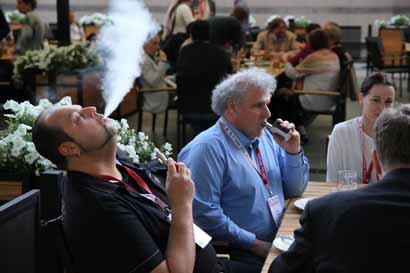Gathering steam

Tobacco harm reduction took center stage at the recent Global Forum on Nicotine in Poland.
By Stefanie Rossel
The fourth annual Global Forum on Nicotine (GFN) took place in Warsaw, Poland, June 15–17. Under the theme “reducing harm, saving lives,” this year’s conference attracted 350 delegates from 54 countries. Attendees not only had the opportunity to listen to almost 50 lectures, but they could also study a variety of posters explaining the most recent research in the field of reduced-risk products.
The GFN is funded exclusively by registration fees, and it attracts a broad base of stakeholders involved with new and potentially safer nicotine products. Participants include academics, public health experts and parliamentarians, along with manufacturers and distributors. Consumers and consumer advocacy groups are involved as well.
The conference was preceded by ISoNTech, an international symposium on nicotine technology, which made its debut this year. Opened by Hon Lik, widely regarded as the inventor of the modern e-cigarette, it gave tobacco companies an opportunity to present research related to their nicotine delivery devices. Tobacco-heating products (THPs) featured prominently this year. Studies conducted by manufacturers suggest these devices deliver significantly lower levels of toxins than do combustible cigarettes.
The GNF was opened by Ethan Nadelmann, former director of the Drug Policy Alliance (DPA) in the United States. The DPA is a nonprofit organization that seeks to decriminalize responsible drug use and promotes harm reduction. In an emotional lecture, Nadelmann urged governments to learn from the mistakes in America’s war on drugs and cautioned against prohibitionist policies for smoke-free nicotine-delivery devices. The illegal market, he warned, would flourish.
Changing roles
The main part of the conference, divided into two tracks with partly parallel sessions, explored the changing roles of public health and manufacturers of reduced-risk products (RRPs) and looked at the conditions under which the interests of tobacco companies and public health might coincide. It also raised the question of whether the rules of engagement, regarding, for example, Article 5.3 of the World Health Organization’s Framework Convention on Tobacco Control, which bans the tobacco industry from participating in tobacco control policy negotiations, needed to be changed now that tobacco companies have products that could benefit public health.
The question about the credibility of tobacco companies’ new research, given their past misuse of science, was partly answered in a presentation on the rapidly developing science on nicotine use. Comparing e-cigarettes, THPs and conventional cigarettes, Konstantinos Farsalinos, a cardiologist at the University of Patras in Greece, reached conclusions similar to those of Philip Morris International (PMI). In Farsalinos’ study, PMI’s iQOS delivered higher levels of nicotine to the aerosol than do e-cigarettes but lower levels than do conventional cigarettes.
The definition of combustion was hotly debated at the conference. A combustible cigarette burns at between 600 degrees and 950 degrees Celsius, according to Thomas McGrath, manager of RRPs at PMI. During the exothermic reaction that takes place inside the cigarette, the tobacco is burned to ash and generates smoke that contains more than 7,000 chemicals. THPs, by contrast, operate at considerably lower temperatures. According to McGrath, the temperature of the tobacco next to the heating element in iQOS reaches a maximum of approximately 300 Celsius—well below the temperature required for combustion, which exceeds 400 Celsius—while most of the tobacco is significantly below 250 Celsius. Contrary to combustible cigarettes, the temperature in iQOS decreases when air is being drawn through the device.
By now, several THPs are available on the market, but there is no standard way yet of assessing whether a product is heating rather than burning tobacco. To comprehensively assess this aspect, a team of British American Tobacco scientists has developed a five-step approach, which they introduced during the poster presentations.
The complex phenomenon of dual use of vaping products and combustible products was another focal point of the GFN. As dual use is a highly individual issue, existing data provide only limited insight. Tom Kirchner, clinical associate professor of public health, medicine and urban science at New York University, described a new model that shows the number of combustible cigarettes displaced by e-cigarettes and essentially is a categorizing or classifying approach.
Nicotine: just another culprit?
The conference demonstrated that the role nicotine plays in tobacco harm reduction for the time being will remain a matter of discussion. Neal Benowitz, professor at the University of California in San Francisco, acknowledged that his concerns about nicotine kept changing as new studies were released. Focusing on the question of whether physicians should recommend nicotine uptake in vaping, he stressed the pharmacological effects of nicotine, which he said include cardiovascular disease, reproductive toxicity, cancer and chronic obstructive pulmonary disease. He concluded that short-term nicotine use posed little cardiovascular risk, whereas long-term use might be harmful.
While the focus currently is on delivering nicotine more safely, Eric C. Donny, from the department of psychology at the University of Pittsburgh, argued that people should be pushed to positive behavior change by reducing nicotine in combustible smokes. While acknowledging that nicotine was not the direct cause of harm, he claimed that it sustained the use of a “vehicle” that was deadly. The availability of alternative nicotine-delivery devices might not be enough to rapidly reduce smoking, he noted; therefore policies were needed that minimized the appeal of cigarettes relative to RRPs. Reducing nicotine in combustibles and enabling the growth of RRPs, Donny said, might be synergistic, complementary approaches to ending smoking.
Snus ban challenged
The second track of the GFN dealt with policy, advocacy and practice. The EU’s longstanding ban on snus featured prominently in this session. Although snus gives a similar nicotine dose as does a combustible cigarette without presenting the same risks for cancer, the product is banned in all EU countries bar Sweden. Looking at 50 years of increasing snus use in Sweden, Lars Ramstrom of the Institute for Tobacco Studies in Sweden stated that patterns of dual use of combustible cigarettes had changed considerably over this period, with snus use gradually replacing smoking. Today, Sweden has a prevalence of daily smokers of 5 percent, by far the lowest in the EU, as well as the lowest tobacco-related mortality rate. If the EU allowed the sale and use of snus, 320,000 smoking-related deaths could be prevented each year, he calculated.
In July 2016, Swedish Match filed a legal challenge to overturn the EU snus ban. Even though its previous challenge, in 2003, failed, experts are optimistic about the outcome of the current case, given that there is now significantly more scientific evidence available to support snus’s harm reduction potential. In addition, because it has so far not been available on the EU market, snus could be claimed to be a novel tobacco product, for which the revised Tobacco Products Directive (TPD2) contains a regulatory path to market.
Unlike snus, e-cigarettes are available in a large number of markets. Nevertheless, electronic nicotine-delivery devices face many challenges as lawmakers struggle to decide the new technology’s place in society, as snapshots of various countries during the conference proved. E-cigarettes are technically illegal in Australia, where nicotine is classed as poison. In spite of restrictions, people are embracing vaping, and the sector has been growing. It remains legal in Australia to import nicotine liquids for personal use. In February 2017, the medicines regulator rejected an application to legalize nicotine-containing e-cigarettes, which leaves combustible cigarettes more accessible than a safer alternative.
New Zealand, which has similar legislation on vaping products, in March shifted its policy. Reflecting the general consensus that vaping is safer than smoking, the government plans to legalize e-cigarettes to help the country become smoke-free by 2025. While sales would be restricted to adults and vaping would be banned in nonsmoking areas, the vapor products would not be subject to tobacco taxation and plain packaging laws.
In Europe, the TPD2, which came into force in May 2016, has significantly changed the business environment for the vapor industry. In countries such as Poland and the U.K., researchers have witnessed the effects on public perception of negative coverage of the vapor industry in the mass media, which is often based on poorly designed and misleading studies.
Other issues tackled at the GFN included the availability of less hazardous tobacco products for certain groups in society, such as people with mental disorders, individuals with addiction issues and poor people (groups that tend to have high rates of smoking prevalence). As far as future regulation of novel nicotine products was concerned, conference speakers said that legislators should promote innovation, set standards on product safety, and give the tobacco and vapor industries appropriate marketing freedom to build new brands. Consumers, on the other hand, should get appropriate freedom to use those products, while they needed to be informed about the risk.







